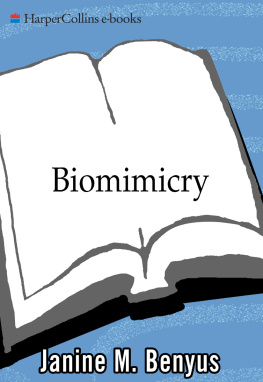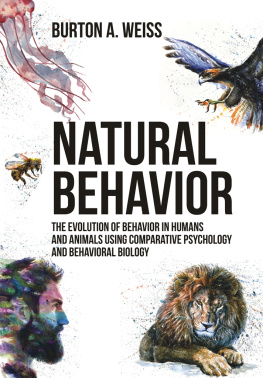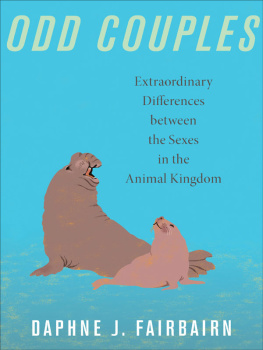The Secret Language of Animals

J A N I N E M. B E N Y U S
Illustrations by Juan Carlos Barberis
F O R E W O R D B Y A L E X A N D R A H O R O W I T Z

THIS BOOK IS DEDICATED
TO THOSE WHO STRUGGLE
TO SAVE WILD LANDS
Contents
Foreword
I saw my first southern white rhinoceros in a zoo. I expect this mirrors many readers experience, substituting Sumatran tiger or polar bear or okapi for my rhinoceros. For most people, that might be their last experience with the animal as well. Zoos are often the only place where most people encounter animals that are not pets, food, or considered urban or rural pests for their ubiquity (read: success). I have gone on to meet other rhinos, in their own habitats, but that first exposure stuck with me.
I was studying those zoo rhinos. In a graduate program of cognitive science, I found myself increasingly interested in the cognition of nonhuman animals, in what we could know about the abilities of species who cannot tell us what they know with words. I joined a series of research programs looking at animal behaviora field called ethologyto equip myself for observing animals with an eye to making inferences about their cognition. One of these groups was watching rhinos; so, thus, did I.
It was a formative experience for me, not just in developing a greater rhino understanding, but in learning how to think about and to look at animals generally. The Wild Animal Park in Escondido, California, where I met these rhinos, is one of the zoos that has turned traditional zoo design a bit on its head: for much of this facility, the animals have large habitats (which they share with other appropriate species), and the humans are constrained to ride trains around the enclosures. As a researcher, I was allowed to sit on the banks of the hills outside the habitat, below the train tracks. But more important, I stayed on the hills for hours, whereas the trains paused only brieflythe trains quick stops mimicking, really, the length of time a typical zoo visitor stands outside an animals enclosure, gazing in. What I saw was that little of the animals behavior could be witnessed from a passing train. The rhinos were visible from the train, but their true selves, their true behavior, was essentially invisible. For instance, as the trains loudly approached, the female rhinos, grazing together, would often stop what they were doing and orient themselves with their rumps together, heads outward, a defensive huddle against this unknown threat. They stayed frozen in this position until the train moved on, at which time they resumed their normal behavior. For the train visitors, I realized, the rhinos appeared to be doing nothing; of course, they werent doing nothing. But to see what the animals were doing, one had to do two things: be informed, and loiter. That is, first, one had to know something about rhinos, for instance, that the species has poor vision; so as a defense mechanism, the animals stay together, each head alert to any possible predator to the group. Second, anyone hoping to learn something about rhinos has to stick around for more than a passing glance and really observe what the animals are doing, not just what one expects to see.
Observation, perhaps surprisingly, is not a simple skill. There is looking, and there is lookingnot just opening ones eyes and seeing, but seeing with fresh eyes, seeing without glibly assuming we know whats happening. Even outside zoos, animals are behaving all around us, but we mostly dont see what they are doing. To watch behavior carefully, and get the idea of what an animal is doing, it is critical that you have an idea who the animal is, where it is from, and what kinds of things it might want, need, and be able to do. An ethologist is not merely a watcher; she or he is a watcher with specific tools.
The Secret Language of Animals is one such tool that will allow the amateur ethologist to begin to truly observe animals. Benyus equips us with the language and the context to see things we otherwise would miss. We learn both how to look at an animals behavior and body to determine where the animal lives and how to do the reverse: to use the animals environment to make sense of its behavior and the design of its body. We learn the meaning of the gorilla chuckle and the lion rump-swivel, the reason for a giraffe neck-slap, and the significance of a panda honk. Armed with one of her case studies of animals before your next zoo outing, your visit will be transformed.
It was a privilege for me to watch those great animals, the rhinoceroses, as it is a privilege to be able to gaze upon the lives of all animals, zood, wild, or domestic. What I have seen has changed me. The secret language of animals is decodable for those who know how to look. The pages that follow hold your code. Go observe!
Dr. Alexandra Horowitz,
author of Inside of a Dog and On Looking
Acknowledgments
To gain perspective on a subject this vast, a writer must stand on the shoulders of giants. Hoisting me aloft were the thousands of researchers who braved white-outs, monsoons, bone-chilling nights, and scorching noons to bring home news of animal behavior. I am indebted to them, as well as to the zoo professionals who shared with me their enthusiasm and fierce devotion to wildlife conservation.
The technical reviewers were Dr. George Archibald, Director, International Crane Foundation, Wisconsin; Dr. Cheryl Asa, Reproductive Biologist, St. Louis Zoo; Dr. John Behler, Curator of Herpetology, Bronx Zoo; Dr. Daryl Boness, Research Zoologist, National Zoo; Dr. Donald Bruning, Curator of Ornithology, Bronx Zoo; Teresa DeLorenzo, Research Affiliate, Metro Washington Park Zoo, Portland; Dr. Sue Ellis-Joseph, Conservation Education Specialist, Minnesota Zoo; Dr. Susan Evarts, Post-Doctoral Associate, Bell Museum of Natural History, University of Minnesota; Dr. Martha Hiatt-Saif, Senior Trainer, New York Aquarium; Dr. Brian Joseph, Veterinarian, Minnesota Zoo; Dr. Jeffrey Lang, Professor, University of North Dakota; Dr. Frank McKinney, Curator of Ethology, Bell Museum of Natural History, University of Minnesota; Dr. Jill Mellen, Conservation Research Coordinator, Metro Washington Park Zoo, Portland; Dr. Jackie Ogden, Research Fellow, Center for Reproduction of Endangered Species, San Diego Zoo; Lisa Rappaport, Behavioral Researcher, Riverbank Zoo, Georgia; Bruce Read, Curator of Mammals, St. Louis Zoo; Dr. Michael Robinson, Director, National Zoo; Conrad Schmitt, Associate Curator, Cheyenne Mountain Zoo; Peter Shannon, Curator of Birds, Audubon Park, Louisiana; Dr. Steve Sherrod, Director, Sutton Avian Research Center, Oklahoma; Dr. Beth Stephens, Research Biologist, Zoo Atlanta; Dr. Lisa Stevens, Mammal Collection Manager, National Zoo; and Scott Swengel, Assistant Curator of Birds, International Crane Foundation, Wisconsin. Their guidance was invaluable, and I thank them.
The Secret Language and Remarkable Behavior of Animals was lovingly birthed by talented midwives. I was fortunate to work with visionary agent Jeanne Hanson, editor extraordinaire Nancy Miller, the illustrious Juan Carlos Barberis, the ever-calm production maestro John Fuller. The fact that these people cared about the book made the whole process a pleasure.
Although writers are not a particularly social species, I have been blessed with a warm circle of friends and family. My thanks to Cynthia Robinson for lending a generous ear during the early stages. For typing gigabytes of notes, editing with a fine eye, and buoying me with her company, I am deeply thankful for Mary Ann Hatton. Laura Merrill, who was as constant as the northern star, gave me the immeasurable gift of hope and laughter, for which I cannot begin to thank her enough. Laura also pored over the galleys, as did Daniel Benyus and La Rue Moorhouse. Even Eight Ball, the enigmatic tomcat who crowded me at the keyboard, played a part. Any errors or pearls of wisdom found on these pages were probably typed in by his paws.
Next page











